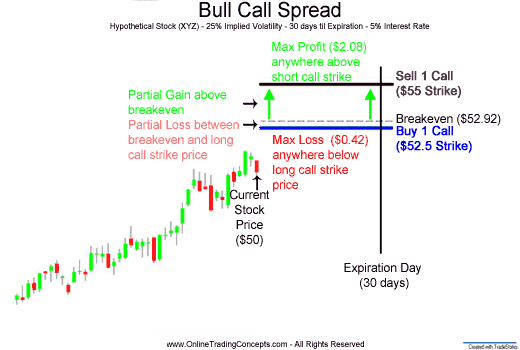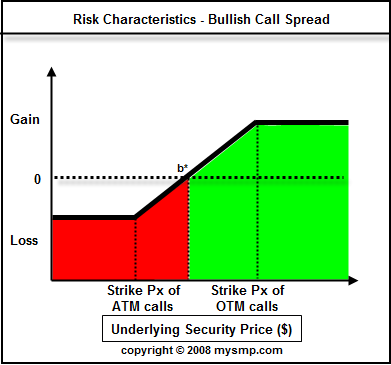What is a Bull Call Spread
Post on: 21 Апрель, 2015 No Comment

Buying a call option gives you the right, but not the obligation, to buy a stock (or financial asset) at the strike price before the call’s expiration. It is a neat way to participate in a stock’s potential upside if you have limited capital and want to only take on a small amount of risk. But what if the call premium is too high? A bull call spread is the answer. (For other types of vertical spreads, see What is a Bull Put Spread? )
Bull Call Spread Basics
A bull call spread is an option strategy that involves the purchase of a call option, and the simultaneous sale of another option with the same expiration date but a higher strike price. It is one of the four basic types of price spreads or “vertical” spreads, which involve the concurrent purchase and sale of two puts or calls with the same expiration but different strike prices.
In a bull call spread, the premium paid for the call purchased (which constitutes the long call leg) is always more than the premium received for the call sold (the short call leg ). This means that the initiation of a bull call spread strategy involves an upfront cost — or “debit ” in trading parlance — which is why it is also known as a debit call spread.
Selling or writing a call at a lower price offsets part of the cost of the purchased call. This lowers the overall cost of the position, but also caps its potential profit, as shown in the example below.
Consider a hypothetical stock called BigBucks Inc. with the ticker symbol BBUX. The stock is trading at $37.50 and the option trader expects it to trade between $38 and $39 in one month’s time. The trader therefore buys five contracts of the $38 calls — trading at $1 — expiring in one month, and simultaneously sells five contracts of the $39 calls — trading at $0.50 — also expiring in one month.
Since each option contract represents 100 shares, the option trader’s net outlay is =
($1 x 100 x 5) – ($0.50 x 100 x 5) = $250
(Note that while commissions are not included in the calculations below for the sake of simplicity, they should certainly be taken into account in real-life situations).
Let’s consider the possible scenarios a month from now, in the final minutes of trading on the option expiration date:
Scenario 1 . BBUX is trading at $39.50.
In this case, the $38 and $39 calls are both in the money, by $1.50 and $0.50 respectively.
The trader’s gain on the spread is therefore: [($1.50 — $0.50) x 100 x 5] less [the initial outlay of $250]
= $500 — $250 = $250.
Thus, excluding commissions, the trader made a 100% return on this option trade.
Scenario 2 . BBUX is trading at $38.50.
In this case, the $38 call is in the money by $0.50, but the $39 call is out of the money and therefore worthless.
The trader’s return on the spread is therefore: [($0.50 — $0) x 100 x 5] less [the initial outlay of $250]
= $250 — $250 = $0.
The trader therefore breaks even on the trade but is out of pocket to the extent of the commissions paid.
Scenario 3 . BBUX is trading at $37.
In this case, the $38 and $39 calls are both out of the money, and therefore worthless.
The trader’s return on the spread is therefore: [$0] less [the initial outlay of $250] = -$250.
In this scenario, where the stock trades below the strike price of the long call, the trader loses the entire amount invested in the spread (plus commissions).
These are the key calculations associated with a bull call spread:

Maximum loss = Net Premium Outlay (i.e. premium paid for long call less premium received for short call) + Commissions paid
Maximum gain = Difference between strike prices of calls (i.e. strike price of short call less strike price of long call) — (Net Premium Outlay + Commissions paid)
The maximum loss occurs when the stock trades below the strike price of the long call. Conversely, the maximum gain occurs when the stock trades above the strike price of the short call.
Break-even = Strike price of the long call + Net Premium Outlay.
In the previous example, the break-even point is = $38 +$0.50 = $38.50.
Profiting from a Bull Call Spread
A bull call spread should be considered in the following trading situations:
- Calls are expensive . A bull call spread makes sense if calls are expensive, as the cash inflow from the short call will defray the price of the long call.
- Moderate upside is expected . This strategy is ideal when the trader or investor expects moderate upside in a stock, rather than huge gains in it. If the expectation was for the latter, it would be better to hold long calls only on the stock, in order to derive the maximum profit. With a bull call spread, the short call leg caps gains if the stock appreciates substantially.
- Risk is sought to be limited . Since this is a debit spread, the most the investor can lose with a bull call spread is the net premium paid for the position. The tradeoff for this limited risk profile is that the potential return is capped.
- Leverage is desired . Options are suitable when leverage is desired, and the bull call spread is no exception. For a given amount of investment capital, the trader can get more leverage with the bull call spread than by purchasing the stock outright.
Advantages of a bull call spread
- In a bull call spread, risk is limited to the net premium paid for the position. There is little risk of the position incurring runaway losses, unless for some unfathomable reason the trader closes the long call position — leaving the short call position open — and the stock subsequently surges.
- The bull call spread can be tailored to one’s risk profile. A relatively conservative trader may opt for a narrow spread where the call strike prices are not very far apart, as this will have the effect of minimizing the net premium outlay while also restricting gains on the trade to a small amount. An aggressive trader may prefer a wider spread to maximize gains even if it means spending more on the position.
- A bull call spread has a quantifiable, measured risk-reward profile. While it can be quite profitable if the trader’s bullish view works out, the maximum amount that can be lost is also known at the outset.
- The trader runs the risk of losing the entire premium paid for the call spread if the stock does not appreciate. This risk can be mitigated by closing the spread well before expiration, if the stock is not performing as expected, in order to salvage part of the capital invested in it.
- There is a possibility of an assignment mismatch if you are assigned well before expiration on the short call leg. Selling a call implies that you have an obligation to deliver the stock if you are assigned, and while you could do so by exercising the long call, there may well be a difference of a day or two in settling these trades.
- Profit is limited with a bull call spread, so this is not the optimal strategy if a stock is expected to make big gains. For example, in the case of the previous example, even if BBUX had appreciated to $45 by expiration, the maximum net gain on the call spread would still only be $0.50 (excluding commissions). But a trader who had purchased only the $38 calls for $1 would see them appreciate to $7 if the stock rises to $45, for a net gain (excluding commissions) of $6 or 600%.
The Bottom Line
The bull call spread is a suitable option strategy for taking a position with limited risk on a stock with moderate upside. Note that in most cases, a trader may prefer to close the options position to take profits (or mitigate losses), rather than exercising the option and then closing the position, because of the significantly higher commission that would be incurred with the latter.














